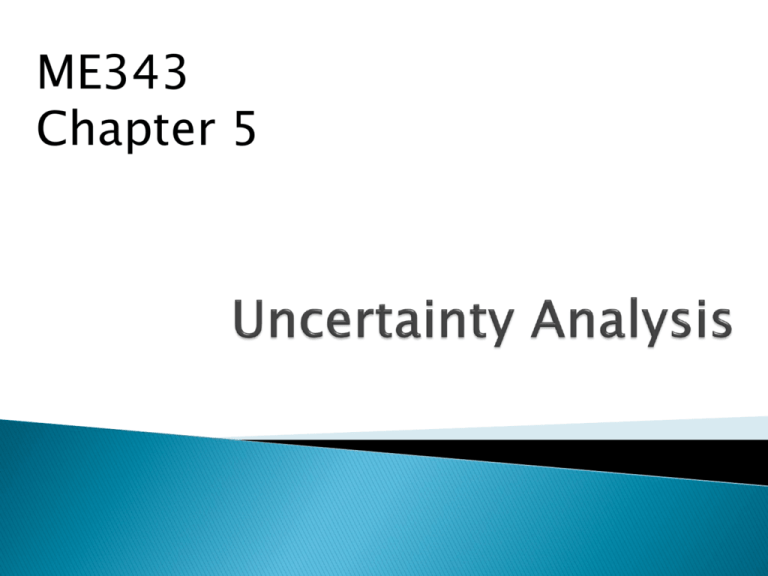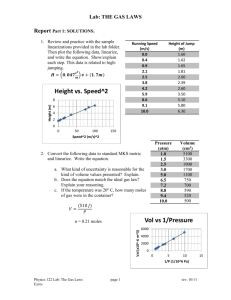Document
advertisement

ME343
Chapter 5
Distinguish two types of uncertainty
evaluation
Do a design stage uncertainty analysis
Calculate error of a derived variable
Handle uncertainty/error propagation from
multiple sources
Use available information to estimate the
uncertainty range, ux, in the interval estimate
of the true value:
For current analysis, assume that the true
value, x’ is constant (time independent).
Statistical Uncertainty analysis (Type A in NIST terminology) –
based on
◦ – series of repeated measurements, and
◦ – calibration tests
• Judgment based Uncertainty Analysis (Type B in NIST
terminology) – based on
◦ – previous measurement data,
◦ – experience with relevant materials and instruments,
◦ – manufacturer's specifications,
◦ – data provided in calibration and other reports, and
◦ – uncertainties assigned to reference data taken from
handbooks
•
•
•
•
Design stage
Calibration stage
Data acquisition stage
Data reduction stage
We apply design-stage uncertainty analysis
when we don’t have the system yet, or have
not tested it yet.
We either rely on the manufacturer’s data, or
on our own estimates
Major facilities may need to be built and
equipment ordered with considerable lead
time.
It is useful for selecting instruments,
selecting measurement techniques, and
obtaining an appropriate estimate of the
uncertainty likely to exist in the measured
data.
At this point, the measurement system and
associated procedures are but a concept.
Usually little is known about the instruments,
and in many cases they are still pictures in a
catalog.
Design-Stage Uncertainty is made up of two
principle components.
1. Instrument resolution
2.
Instrument uncertainty, uc, (an estimate of
the systematic error for the instrument)
• Treat an error as:
– Precision error if it
can be statistically
estimated in some
manner (data scatter)
– Bias error otherwise
(cannot be directly
discerned by statistical
methods, e.g. By
repeating
measurements).
Calibration
Alternate
(concomitant) Method
Interlaboratory comparisons
Experience
System repeatability and resolution
(measurement system)
Temporal and spatial variations
(measured variable properties)
Operating and environmental conditions
(process)
Measurement repeatability
(measurement procedure and Technique)
A temperature measurement system is
composed of a sensor and a readout devices.
The readout device has a claimed accuracy of
0.6˚C with a resolution of 0.1˚C. the sensor
has an off-the-shelf accuracy of 0.5˚C.
Estimate a design-stage uncertainty in
temperature indicated by this combination.
The design-stage uncertainty is for the combined system is
where (ud )R is the design-stage uncertainty of the
readout device and (ud)s is that of the sensor. In either
case, the individual design-stage uncertainty is found
from
Sensor
The linear displacement of a vehicle due to an applied impact
force is measured with a transducer. Transducer specifications
are:
Input range : 0-5 m
Output range: 0-5 V
Linearity:
± 0.25% reading
Drift:
± 0.05%/˚C FSO
Sensitivity: ± 0.10% FSO
Hysteresis: ± 0.25% reading
The transducer output is indicated on a voltmeter
(accuracy: within ± 0.1% reading; resolution: 10μV). The
expected nominal displacement of the vehicle is to be 4m for
an impact force of 2000± 100N (95% ).
The force-displacement relation can be assumed linear.
Four replications consisting of 10 measurements are
made over the course of one day. The results are given
with the ambient temperature for each run.
Test run
N
1
10
Mean
value
[m]
4.3
2
10
3.8
3
10
4.2
4
10
4.0
At the design-stage, only information known
prior to the test are included:
◦ For the transducer, we estimate the instrument
error from the elemental errors:
eL = ± (0.0025)(4m) = 0.01 m
eH = ± (0.0025)(4m) = 0.01 m
es = ± (0.001)(5m) = 0.005 m
eD = ± (0.005/˚ C)(3˚C)(5m) = 0.0075 m
so that,
The transducer has a sensitivity Kt = 1V/m so
that the voltmeter output can be restated in
terms of displacement [m].
For the voltmeter:
For the transducer-voltmeter system, the designstage uncertainty is:
Now we look at the case of a derived quantity that
is estimated from the measurement of several
primary quantities.
The question that needs to be answered is the
following:
“A derived quantity Q is estimated using a formula
that involves the primary quantities. a1,a2,.....an
Each one of these is available in terms of the
respective best values b1, b2,.....bn and the
respective standard deviations σ1,σ2....σn . What is
the best estimate for Q and what is the
corresponding standard deviation σQ ?”
We have, by definition Q =Q(a1,a2,.......an )
It is obvious that the best value of Q should
correspond to that obtained by using the best
values for the a’s. Thus, the best estimate for
Q given by
Q Q(b1 , b2 , b3 , .....bn )
by definition, we should have:
The subscript i indicates the experiment
number and the ith estimate of Q is given by
Qi = Q(a1i ,a2i ,....ani )
using a Taylor expansion around the best
value as
where the partial derivatives are all evaluated
at the best values for the a’s. If the a’s are all
independent of one another then the errors in
these are unrelated to one another and hence
the cross terms.
The equation can be written as:
Noting that
the above equation can be in the form
the error propagation formula
Two resistors are to be combined to form an equivalent resistance
of 1000. Readily available are two common resistors rated at
50050 and two common resistors rated at 20005%. What
combination of resistors (series or parallel) would provide the
smaller uncertainty in an equivalent 1000 resistance?
Case 1 (series resistors)
RT = R1 + R2
If we use the two 500 resistors, then
ud 1 50 , ud 2 50
The propagatio n of uncertaint y through to RT is estimated by
RT
RT 2 1 2
2
(ud )series = [(
ud1 ) (
) ]
R1
R2
= [(1.u d1 )2 ( 1.ud 2 )2 ] 71
(95%)
Case 2 (paralell resistors)
If we use the two 2000 resistors, then
ud 1 100 , ud 2 100
The propagatio n of uncertaint y through to RT is estimated by
RT
RT 2 1 2
2
(ud )paralell = [(
ud1 ) (
) ]
R1
R2
1
R2
R1 R2
R1
R1 R2
2
2
= [({
}.ud 1 ) ({
}ud 2 ) ] 2
2
2
R1 R2 ( R1 R2 )
R1 R2 ( R1 R2 )
35
(95%)
Heat transfer from a rod of diameter D immersed in a
fluid can be described by the Nusselt number Nu=hD/k,
where h is the heat transfer coefficient and k is the
thermal conductivity of the fluid. If h can be measured
within 7% (95%), estimate the uncertainty in Nu for the
nominal value of h=150 W/m2-K. Let D=200.5 mm and
k=0.62% W/m-K.
uh = (0.07)(150) = 10.5 W/m2-K
uD = 0.0005 m
uk = (0.02)(0.6) = 0.012 W/m-K
We have Nu = f(h,D,k)
1
2
N
N
N
u Nu ( u uh )2 ( u ud )2 ( u uk )2
D
k
h
u Nu
u Nu
h
hD
D
2
2
2
( uh ) ( u D ) ( 2 uk )
k
k
k
1
2
1
2
150
150 x0.005
0.02
2
2
2
(
10.5 ) (
0.005 ) (
0.012 ) 0.4
2
0.6
0.6
0.6
Then, we estimate the Nusselt number here
to be
Nu = hD/k uNu = 5 0.4 (95%)
So, Nusselt number can be determined within
about 8% in this range of values.








